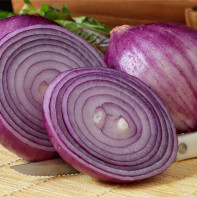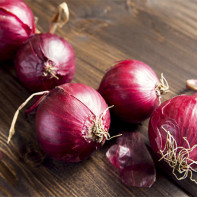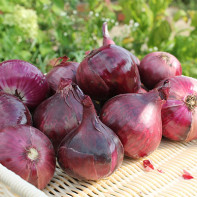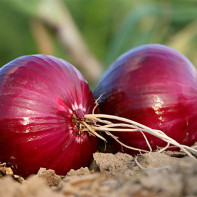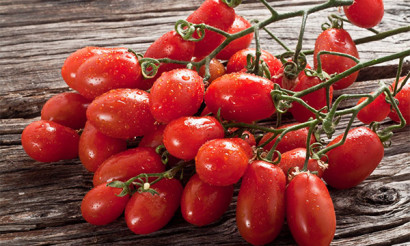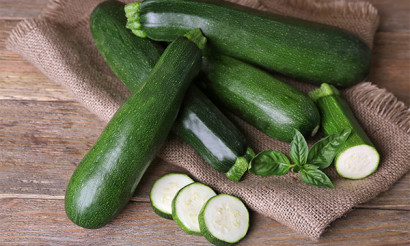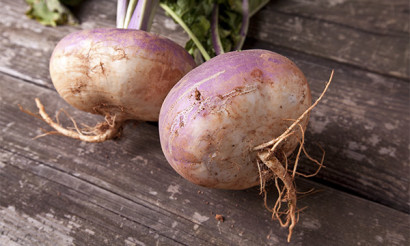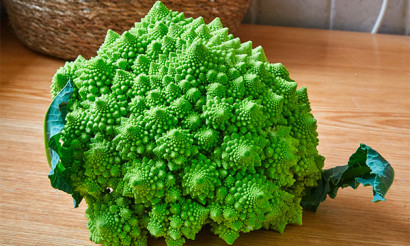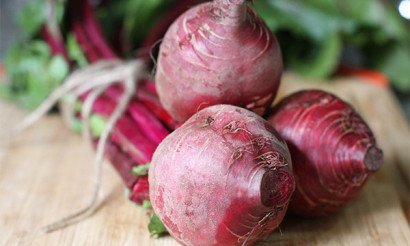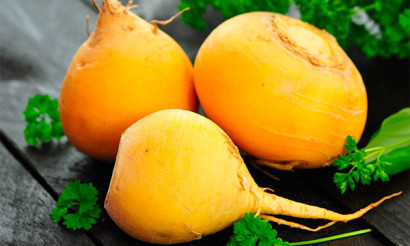Blue onion: useful properties and contraindications
In nature, onions that have a true blue color do not occur. Blue includes varieties that have a color from light purple to almost black with purple and bluish hues. The taste is slightly sweet. But varieties grown in damp soil with a lack of sunlight are sharper than turnip yellow. Sweet varieties: "Yalta", "Albina". The latter is expensive because of its low yield and is extremely rare.
- How blue onions differ from ordinary onions
- Which is healthier
- Composition and calories
- What are the health benefits of blue onions?
- General benefits
- For Women
- For Men
- Pregnancy
- For breastfeeding
- For children
- When losing weight
- Traditional Medicine
- Harm and Contraindications
- How to choose and store
- What can be cooked from the blue onion: recipes
- Fish dish
- Pasta for sandwiches
- Gravy for Potato Cakes
- How to marinate blue onions
- Can I Fry Blue Onions?
- Fun Facts About Onions
What is the difference between a blue onion and a common onion?
The main differences are caused by the difference in the chemical composition:

- Blue varieties have less potassium, rubidium is absent, which slightly slows the heart rate, while onions, in large quantities, can lead to bradycardia.
- Blue varieties have fluoride, which strengthens tooth enamel, but are contraindicated if there is an excess of this chemical element in drinking water.
- Blue varieties have a milder effect of sulfur, so there is less irritation to the GI tract.
- Purple onions have more lutein - minimizing the irritant effect on GI mucosa slightly thickens the blood compared to onions.
- Purple varieties have more iron, which helps transport oxygen through the blood.
- Dark varieties have less vitamin B4, so the diuretic effect is weaker than light varieties.
Other differences:
- Gains an unpleasant bluish hue when cooked.
- The flavor range is richer than that of the usual, so there is the possibility of using in spicy non-spicy sauces, ideal for seafood, sandwiches.
- Blue onion is more demanding to storage conditions, with a lack of heat will be shallow, burning with a bitterness.
- In contrast to the usual, the characteristic smell of the mouth lasts no more than 20 minutes.
Which is healthier
The degree of usefulness depends on the purpose of application:
- Viral diseases - turnips are healthier. The exception is purulent sore throat with significant mucosal damage. In this case, use only light purple, sweet - 1 to 1 with oil and honey.
- Diseases of the liver of an infectious nature, steatosis - any variety of blue to 1 part onion and 3 parts honey. Take sweet varieties. Bitter ones accelerate the withdrawal of fluid from hepatocytes.
- Prevention of viral diseases, gastrointestinal disorders (putrefactive processes, reduced acidity of digestive secretions) - blue onion is preferred. He strengthens the immune system naturally, rather than replacing its action. The action of onions is similar to antibiotics - local effect plus acceleration of dead phagocytes out of the body.
- Arrhythmia, blood pressure spikes, CNS disorders - only blue. It has a lower concentration of metals from the first column of the Mendeleev Table, there is no harsh ionizing effect, as when using onions.
- Helminthiasis, skin infections - onions. It is also more effective with high fever or if it rises intermittently for 3 days or longer, as there is less chance of fermentation in the gastrointestinal tract. Stomatitis, gingivitis, herpes - 1 to 1 with honey plus 1/3 alcohol of the total.
- Weakness, dizziness and other symptoms of cardiovascular disorders and iron deficiency - blue onions. Use with lean meat, pork or veal liver, and fish to increase efficiency.
Composition and calories
The caloric content of blue onions depends on the saccharide content of the bulb. The average caloric value is 40 kcal/100 g. In sweet and non-sugared varieties, the caloric value may exceed the average by 20-30%. In the sweet burning ones, phytoncides break down carbohydrates during digestion, reducing calories by 30-40%.
Blue onion varieties contain the following chemical elements and bioactive substances.
Vitamins:
- B4: Acceleration of fluid separation in the small intestine, a slight decrease in acidity in the GI tract (the properties are manifested when the vegetable is consumed raw).
- B9: Increasing the likelihood of conception, slowing the synthesis of histamine, prostaglandins - relieving inflammation (found in large quantities, concentration increases with frying, drying).
- C: Strengthening immunity, increasing iron absorption efficiency, accelerating fluid metabolism.
- E: Strong antioxidant, slowing cell aging processes (high concentration).
- H: Accelerating protein metabolism, gaining muscle mass, increasing myofibril muscle fiber density (low concentration).
- K: Increase blood clotting, stimulation of bone marrow hematopoietic function (low concentration).
- PP: Accelerating the passage of nerve impulses in the cerebral cortex, along with phosphorus and magnesium, strengthening blood vessel walls (found in low amounts).
Minerals:
- Potassium: slowing the rhythm of the heartbeat, speeding up metabolic processes, uniform distribution of substances in the blood (high concentration).
- Calcium: Accelerating the rhythm of the heartbeat and oxidative processes, strengthening bone tissue (contained in small amounts).
- Iron: Is part of molecules that transport oxygen through the blood (transferrin, hemoglobin), in large quantities destroys bone tissue (low concentration).
- Magnesium: Strengthening blood vessel walls, accelerating fluid metabolism, normalizing redox processes (found in small amounts).
- Sulfur: Stimulation of amino acid absorption, mitigation or stabilization of allergic leaks (in small amounts).
- Fluoride: Strengthening dental enamel, neutralizing ionizing effects of potassium, rubidium (low concentrations).
- Chromium: reduction of local temperature in areas of inflammation, slight stabilization of blood sugar levels, forms toxic bichromates with potassium and rubidium (low concentration).
- Zinc: In small amounts normalizes phospholipid metabolism, improves blood circulation in capillaries (low concentration).
Blue varieties of onions are rich in lutein, which provides a bactericidal and tonic effect.
What are the benefits of blue onions
General health benefits
Blue onions have the following beneficial properties:
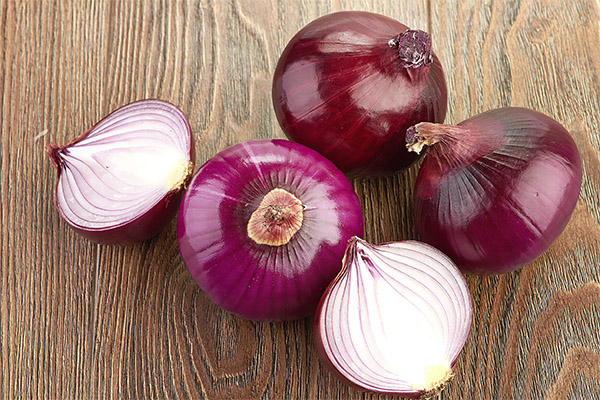
- Immunomodulatory action, which eliminates the onset of autoimmune disease.
- Mild cleansing of the mucous membranes - pus accumulates in non-bulky lumps, which are removed from the body through the feces, the mucous membranes are not liquefied.
- Increasing the elasticity of the skin, blood vessels.
- Facial care. When used externally it does not dry the skin - can be used to clean the face, masks do not shrink the skin, wrinkles are excluded.
- Protection against parasites. When running helminthiasis provides a uniform withdrawal of adults and their larvae, minimizing the likelihood of asphyxiation.
- Increase appetite.
- Accelerating the digestion of animal fats.
- Elimination of stagnation of digestive secretions not caused by duct obstruction.
- Improved well-being.
- Normalization of sweating.
- Stimulation of a uniform distribution of oxygen in the blood and tissues.
- Mild sedative effect, greatly increased in combination with honey.
- Increase the strength and elasticity of tooth enamel, reducing its vulnerability to organic acids.
- Reducing the damaging effects of lactic acid on the muscle fibers after their overstrain.
- Normalization of body weight.
- Destruction of small cholesterol plaques with their subsequent excretion with the urine.
- Acceleration of liver cell regeneration.
For women.
Blue onions increase libido and reproductive function due to a combination of folic acid, sulfur and chromium.
Other beneficial properties for the female body:
- Normalizing body weight during cyclical hormonal changes.
- Mitigation of menopausal symptoms through systematic use.
- Improvement of elasticity, elasticity of the skin, normalization of its acid-alkaline balance, both external and internal use.
- Slowing the formation of cellulite deposits.
- Acceleration of hair and nail growth.
- Reducing the intensity of pain during menstruation.
- Support the elasticity of the vocal cords (lutein).
For Men
The main benefit of blue onions for men is the strengthening of bone tissue. With daily use and dosed physical activity will be followed by the recruitment of muscle mass. Systematic use reduces the likelihood of prostate diseases. If there are no contraindications, using 1-2 bulbs a day, you can get rid of urethritis at the initial stage.
Blue varieties indirectly improve potency, relieve inflammation, strengthen blood vessels, improve blood flow to the cavernous bodies. To improve erectile function, you need to consume at least 2 medium raw onions a day.
In pregnancy.
The main function of blue onions during pregnancy is to normalize the balance of estradiol and progesterone. The combination of potassium, calcium and vitamin B9 keeps the uterus in optimal tone for the corresponding trimester.
Other properties:
- Strengthening the fetal skeleton;
- Minimization of swelling of the limbs, the mother's face;
- maintaining fluid balance;
- Elimination of dyspeptic phenomena, typical in this period;
- Prevention of postpartum stretch marks.
During breast-feeding.
The components penetrate the mother's milk. Consequently, it strengthens the immune system of the baby. The natural appetite allows a quicker transition to complementary foods and ensures the physical and mental development of the baby without delay.
Blue varieties of onions ensure timely receipt of all necessary nutrients through the mother's milk, which is good to minimize the risk of diathesis, timely growth of milk teeth with minimal pain.
For kids
Children can add blue onions in food in raw form, starting from 3 years, in boiled form - from one year. The main effect - resistance to disease or their rapid progress in a mild form. Phytoncides adapt mucous membranes to external stimuli, increase protective functions.
Systematic use of blue onions in small quantities minimizes the likelihood of childhood constipation. The intestinal microflora is stabilized from an early age, ensuring high efficiency of absorption of useful substances from food, low probability of food poisoning.
Children who eat onions in raw form from early childhood are not susceptible to helminth infections, maxillitis. The exception - extraintestinal helminths: dirophilaria, anthrax, ankylostoma, toxocara. In these helminth infections use of onions is shown only after a comprehensive treatment.
Grated onions with raw yolk eliminates the manifestation of weakness in avitaminosis. If you listen to the child, the vitamin balance is restored within a week, and the consequences of avitaminosis are eliminated in 7-10 days.
When losing weight.
Blue onion accelerates the course of metabolic processes in the body, due to which the appetite increases. The effect of weight loss is observed due to the burning of fat. In order not to exhaust the body, you need to eat a balanced diet. The menu should include fish, chicken, beets, carrots, pineapple, buckwheat, low-fat dairy products. Rye bread, onions should not be combined with dairy products, as heartburn will appear. It is also necessary to take a metered amount of exercise and not to strive for quick weight loss. This brings with it the destruction of the gastrointestinal mucosa, stretch marks on the skin, disproportionate muscle development.
Anti-cellulite massage can be done on the problem areas. Grate 1 medium onion on a fine grater. Add 1 tsp. honey, warmed in a water bath. Beat 1 egg yolk to a foam. Gradually add to the mass, stirring it quickly. In addition to the fact that the anti-cellulite massage cream evenly destroys deposits, it also enriches the skin with vitamins, removes the "orange, goose skin". Massage in a circular motion for no longer than 2 minutes. Rinse off with warm boiled water. If the skin is dry add a tablespoon of vaseline to the mixture. Store the cream in the refrigerator. It is enough for 4 sessions on 90 cm hips. When massaging, the skin should completely absorb the mixture. Dark deposits may remain on the hands - this is dead epithelium. Before applying, rub the area well with the palms of your hands. The skin will "tell" itself how much cream to apply. After massaging with the index fingers, rub again with the palms of your hands.
The food should be tasty, not hard for the stomach. Take a glass of buckwheat grits, 200 g of chicken fillets, 300 g of crab sticks, 2 large onions for 1 liter of cold water. Bring buckwheat groats and meat, chopped in any pieces, bring to a boil, put on minimum heat, bring to a half-cook, add chopped onions. Boil until tender. Salt. Add the crab sticks and bring to the boil. Add 1 tbsp. finely chopped parsley, 1 tsp. dill. Turn off.
Use in folk medicine
Blue onion is used in folk medicine to remove blisters and pustules, to get rid of coughs, to soften the course of colds.
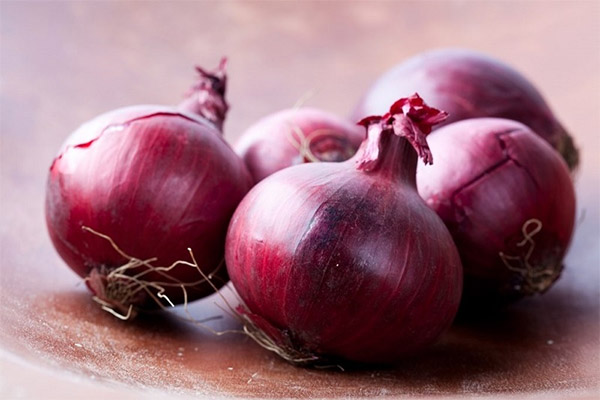
- Bring a glass of honey to a boil in a water bath. Grind 1 kg of peeled onions into a pulp, pour boiling honey. Allow to cool. Use the mixture for 2 days with angina and or a dry cough. Also effectively removes boils. Put it on a cotton pad, fix it with a plaster.
- Mix onion pulp and softened butter 1 to 1. Apply to the feet for 5-7 minutes. The mixture is effective for hardened skin on the feet, corns. Do not use more than once a day. Rinse with warm water without soap. After the application should not leave a greasy film.
- Mix 3 tablespoons of onion pulp with 1 tablespoon of aloe. Leave it for 6-8 hours, stirring every hour. Then add 1 tsp. grinded lemon peel and candied honey. Insist 2 days, stirring every 6 hours. Apply the mixture in a very thin layer. Do not use with internal pustules, blood infections. Use with caution on face as burns may occur.
Inhalation
Take 1 kg of raw onions for 3 liters of cold water. Insist 10-12 hours. Bring to a boil. Add 4-6 bay leaves, 5 tbsp. plantain. Use with a cough of infectious nature. Breathe for no more than 30 seconds. The mixture can be used for foot baths as a strong antifungal agent.
For a cold compress.
Bake unpeeled onions in the oven. Pour hot into a bowl. Mash and add 2 tbsp mustard per 1 kg. Put into a plastic bag, wrap in 2-3 linen towels and put on your back. Do not use children under 12 years of age - asphyxiation is possible. Cooled mixture can be used to treat infectious skin diseases. When abscesses, add 6 tbsp. honey, 4 tbsp. Vaseline oil and knead.
Harms and contraindications
Blue varieties, unlike yellow ones, do not burn out the mucosa as much. Such an effect can be achieved only by daily consumption of the vegetable of 2 or more bulbs, not including fatty and meat products in the diet. Purple varieties also increase blood and GI acidity. If you abuse salads with onions, cabbage, increases the likelihood of fermentation of hard to break down fiber, which is fraught with dysbiosis 2, 4 degrees. Dark varieties cause flatulence, so you should not combine them with legumes.
Do not consume blue onions with the following body conditions and diseases:
- Ulcers, gastritis, spastic colitis;
- Partial or complete obstruction of the intestines;
- Gall bladder stones, kidney stones;
- Non-infectious kidney disease;
- acute stage of liver, pancreatic disease;
- extraintestinal helminths;
- cardiac and renal insufficiency;
- high mucosal sensitivity;
- allergies.
Important! Dried onions are contraindicated in slow heartbeat, low blood pressure, brittle bones. To reduce the concentration of potassium in the blood, you need to add citric acid to your dishes, eat more sea fish, seaweed. The latter goes well with the blue varieties.
How to choose and store
If a batch of onions gives off a bad smell, you should not even consider it as an option to choose. There should be dry onions in the box. The skin should come off freely, making a uniform rustling sound. No moisture should protrude underneath it.
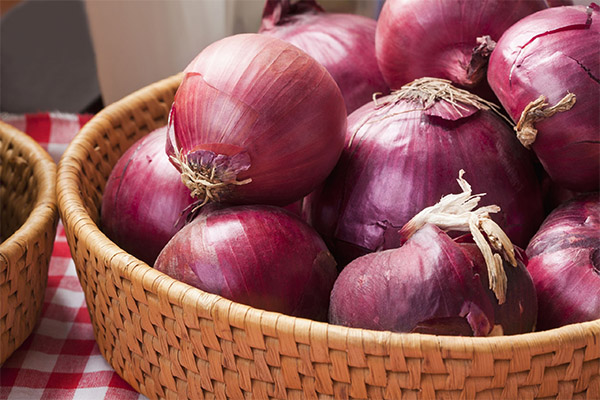
It is better to take bulbs of medium density. Too dense and dry indicates that it is last year's crop, and large and wet - that it was gradually watered. The tails should be completely dry. There should be no spring between the tail and the bulb. The tail should go smoothly into the bulb. If there is a significant compaction near the root and tail, the onion was planted to seed. This means that there will be a woody middle.
Small onions, perfectly dried, with a slightly pungent smell, will keep for a long time, but there is a bitterness in them. Small, perfectly dried, with a spicy odor, has a high concentration of fructose. Sweet is ideal for canning, children, to fish sandwiches. It should be kept in suspension. Contrary to all assurances, in a dry place at 18-25°C it will keep until spring. Medium-sized sweet onions are best stored either in a wreath or in a cardboard box near a convector. If it begins to dry out, put 200 ml of water on the convector overnight, changing every 24 hours. Stack only perfectly dried onions, otherwise the middle and lower layers will sprout.
Do not store raw materials near sources of damp heat. Sweet onions like offline storage. It should not be stored with garlic, as it germinates quickly. Sweet onions begin to rot in the middle, the upper layers become tough. In the fridge, the vegetable loses sweetness and becomes tough. Onions are excellent in frozen sauces with plums and tomatoes. It takes away the bitterness in vegetable mixes that include bell peppers.
What you can make with blue onions: recipes
Blue onions are included in first courses, sauces, salads, stews if they need to be softened.
Fish dish.
If the herring is not first fresh, its specific flavor can be veiled as follows. Pass boiled or canned corn through a meat grinder. Grind the onion into a pulp. In a container loosely lay herring fillets, onions, corn, boiled eggs, cut into thin rings, grated cheese, smearing all the layers with mayonnaise. Put the layers in the same order until you are done with the herring. You can grate 1 kg of boiled beets on a coarse grater. You can also cut 0.5 kg of herring fillets into julienne strips and 200-300 g of onions into coarse strips. Do not salt, the herring will give up the salt. Add mayonnaise.
Pasta for sandwiches
Take 1 medium onion mush for 200g of cottage cheese, 1 tbsp finely chopped dill, 2 tbsp mayonnaise and salt to taste. Spread the paste on slices of loaf. Put tomato rings and slices of sweet pepper. With this paste you can bake the loaf. Cut the loaf as for a hot dog. Bottom - pasta, then hunting sausages or smoked sausages, pasta, bell peppers, pasta, crab sticks. Pour plenty of pasta on top and bake. For baking, it is better to grate hard cheese. With cottage cheese, the mass does not melt well. If the cheese is low-fat, add (for 200 g grated cheese 4 tbsp mayonnaise and mush from 2 onions). If with grated cheese, bake the loaf in the oven, wrapped in 1 layer of foil. Smear the top of the loaf evenly with a thin layer of butter.
Beat a piece of beef 3 by 4 cm, 1.5 cm thick. After battering, the parameters should double in size. Mix 1 kg of fatty minced fish with 1 tsp. salt, 2 tbsp. semolina. Spread on the chopped beef. 0.5 kg of peeled onions cut in coarse julienne, sprinkle on the mince. Roll up into a tight roll and secure with toothpicks. Wrap in 3-4 layers of foil. Bake for 40-50 minutes at temperature no higher than 140. The roll should come out juicy. Unwrap after it has cooled down completely. If minced meat is very greasy grate 400 gr of non-hard cheese for 1 kg. Such a roll can be unwrapped warm.
Gravy for the potato cutlets
1 kg peeled onions cut into rings. Stew in lots of butter (about 400g). Add 300g chopped bell peppers and 0.5kg mushrooms to half-cooked onion. Let it stew until it is ready and salt it. Blanched mushrooms in a colander beforehand, otherwise the remaining water will soften the vegetables.
How to pickle blue onions
For marinating, it is better to take a small onion, making sure that the middle is not hard. There should not be a significant space between the plates.

- Peel the bulbs, wash, tightly placed in a clean jar. The optimum option is a capacity of 1 liter. For 1 liter of onions take 100 ml of vinegar, 4 tbsp of sugar, 1 tbsp of salt (incomplete). Pour steep boiling water. Sterilize for 5 minutes from the moment of boiling syrup in the jar. After 12-16 hours, remove to a cool dark place. In the refrigerator pickled onions lose refinement of taste. Shelf life of 2 years. Use in 2-2.5 months.
- Washed peeled onions cut into large rings. At the bottom of the jar - currant and cherry leaves (5-7 pcs.). In the jar, place a layer of onions, pitted cherries, onions and currants. The top layer - cherries. For 1 liter take 5 tbsp of sugar, 50 ml of vinegar. If calculated for beet salads, do not add salt. For sandwiches, 1 tbsp of salt (incomplete) is enough. Sterilize for 10 minutes from the boiling point of the syrup. Shelf life is 1 year. Ready for use in 1.5 months.
Can I Roast Blue Onions
In fried form, it comes out tastier than the onions and somewhat resembles opyat. Fry the onions on low heat in a small amount of fat. Dry a frying pan. Pour sunflower or olive oil, wait until it boils. Place chopped onions. Animal fats are not suitable for blue onions. Very tasty comes out with butter.
If the onions are near the end of their shelf life, they can be stewed in plenty of butter or spread. Cool, pour into a container and freeze. For freezing, it's best to use stainless steel containers and spreads. Butter gives a specific flavor over time. If you freeze stewed or fried onions in vegetable fats, you can add lots of chopped herbs to them. This keeps the aroma and flavor fresh in an excellent way. For frying in vegetable fat onions are better to cut into large pieces, so they do not burn, forms a crust, preserves juiciness, but in butter - very small.
Interesting facts about onions
- The maximum useful substances are in the top layer. Even if it's stiff, you shouldn't throw it away! Blanching takes away the hardness.
- Sweetness and bitterness depend not so much on the variety, but on the soil in which it was grown, the amount of precipitation during the season, the average daily amplitude of temperature fluctuations.
- Dark varieties are the result of crossing Spanish and Portuguese onions. For maximum manifestation of all the taste and medicinal properties, it should be grown on stony soil with a fertile layer of no more than 30 cm. Stones give off heat at night, which ensures a twenty-four-hour even vegetation.
- It is necessary to fertilize the soil with poultry manure, straw, cattle manure, taking all components in equal parts. Such fertilizer slowly decomposes, which eliminates the rotting of bulbs, keeps heat well in the soil.
- Bitter varieties are better not to take for canning. After soaking, the onion flavor intensifies, the bouquet of specific flavors disappears. If this happens, for marinade take 0.5 l of cherry and plum juice, a glass of sugar, 150 ml of vinegar, 1 tbsp of salt. The marinade is enough for 3-4 liter jars, depending on how it will absorb the onions. Bring the marinade to a boil over low heat, stirring occasionally. Do not put on jars that are too full. The onions can absorb the marinade a lot, will increase in volume. Sterilize for 10-12 minutes, use in a month. Shelf life - a year.
«Important: All information on this site is provided for informational purposes only purposes only. Before applying any recommendations, consult a health care professional. specialist. Neither the editors nor the authors shall be liable for any possible harm caused by materials."

